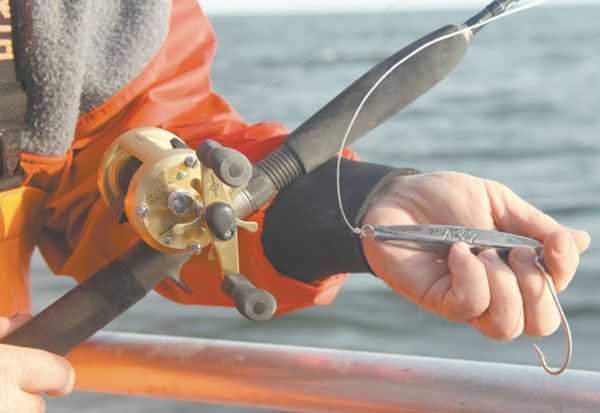Choosing A Fishing Rod: Fiberglass vs. Graphite and Composites
Most rods blanks today are made of fiberglass, graphite or a composite mix that includes graphite, boron or even a ceramic additive. While much has been made of the differences between these materials, they aren’t hard to understand – and all three have advantages and disadvantages.
Fiberglas rods are generally the least expensive. They are also the least sensitive, and the least powerful when it comes to muscling big fish. These rods usually flex in a parabolic curve, meaning that the entire rod bends from tip to butt when you lift up on a weight at the end of the line. This flexing is known as a rod’s action. The more a rod flexes throughout its length, the slower the action is said to be. That’s because action is really response – the amount of time it takes a rod that has been flexed to return to its straight or stiff position.
Fiberglas rods usually fall in the slow- to medium-action class. They are great for soft presentations of large baits, an excellent choice for working rough bottom where hang-ups are the norm, ideal for tangling with soft-mouthed species such as weakfish from which stiffer rods might tear the hook, and they are durable enough to take the pounding that novice anglers typically dish out.
At the other end of the spectrum, graphite rods tend to be the most expensive choice on the market today. They are the most sensitive and the most powerful when it comes to lifting weight. They also have the fastest action. That’s because, with graphite rods, only the rod-tip to the first-third of the rod flexes. With so little flex along the rod’s length, these rods are usually rated as having fast- or extra-fast action. In other words, since most of the flex is in the tip, they go from flexed to stiff almost instantly.
The upside of this fast action is super sensitivity – you can just about feel the tremors as a starfish crawls along the bottom a foot away from your hook. Thus, these rods are great for bucktailing, diamond jigging and tossing lures where you’ll want to strike at the slightest hint of a bite. The downside is that these rods are slightly more prone to snap than fiberglass rods, and too much sensitivity can have you trying to set the hook at the slightest bump on the bottom.
Think of the difference between fiberglass rods and graphite rods as being similar to the difference between a swamp maple and an oak tree blowing in the wind. The oak is stronger and quicker to resume its stiff position than the swamp maple, but the maple can sway in the breeze without snapping. Picking a rod, to a large degree, is finding the right amount of sway to meet your needs.
Composite rods incorporate both fiberglass and graphite or other fibers in their design. As you might expect, then, they perform somewhere between the two extremes. They generally cost more than fiberglass rods but less than graphite, are more sensitive than fiberglass but less sensitive than graphite, and, although not quite as powerful as graphite on the lift, they are less likely to snap under heavy or sudden loads.
Combining the benefits of fiberglass and composites results in a rod with increased sensitivity, more durability and great strength. This makes for a nice blend of characteristics and thus, composite rods are often the best choice if versatility is what you are looking for in an inshore rod.
The action on a composite rod is determined by how far down the blank the fiberglass and composite materials meet. Look carefully, and you can actually see where the two elements blend together. That’s where your rod will flex. Most composite rods fall into the medium to medium-fast action range, meaning that they flex from the tip to somewhere between one-third and one-half-way down the rod. If you aren’t sure about the action for a particular rod, you can always check the label. Most manufacturers print the action right on the rod shaft, some even note what strength line, size weights or lures, and fishing techniques the rod is designed to handle.
Of course, fishing rods are like clothes; there are different fits for different tastes. So choosing a rod has nearly as much to do with personal preference as it does with practicality. There isn’t necessarily a right choice and a wrong one for any fishing situation. The best choice is a rod that will get the job done in way that feels good in your hands.
The place to start when choosing any rod is matching the rod type to the technique for which it will be used. Once that’s done, you can match the rod’s power to the size and strength of the fish you’ll battle before considering the rod’s action.
While it’s possible to pick a rod by running all the factors through your head, I still prefer a hands-on approach before making my final decision. After determining the basic style I need, I take a 20-inch length of line and tie the size weight or lure I’ll be using most often to the tip of a rod I’m considering buying. This way, I can check the rod’s action and get a first-hand feel for its power at the same time. If I’m satisfied with the rod’s response, I next tie on the lightest and then the heaviest weight or lure I expect to use. This gives me a good indication of how the rod will react under a range of conditions.
Unless you are willing to shell out the bucks for a custom-made rod, sticking with brand-name manufacturers is the way to go. As a rule, the better-known names in rod manufacturing combine the best materials with the latest and greatest technology to increase the strength, sensitivity and durability of their products.
For superior sensitivity, St. Croix graphite rods are tough to beat. If you want a rod that can take a pounding day-after-day and year-after-year, check out Shakespeare’s Ugly Stick series. Daiwa Corporation’s composite rods are more affordable than you might think. I’ve also had good luck with Seeker, Star and Penn rods of various models.
In the end, the best ways to choose a rod are to visit your local tackle shop or ask a fishing friend who likes to target the same species as you do using the same basic techniques. When it comes to making the best choice, nothing beats the voice of experience.












